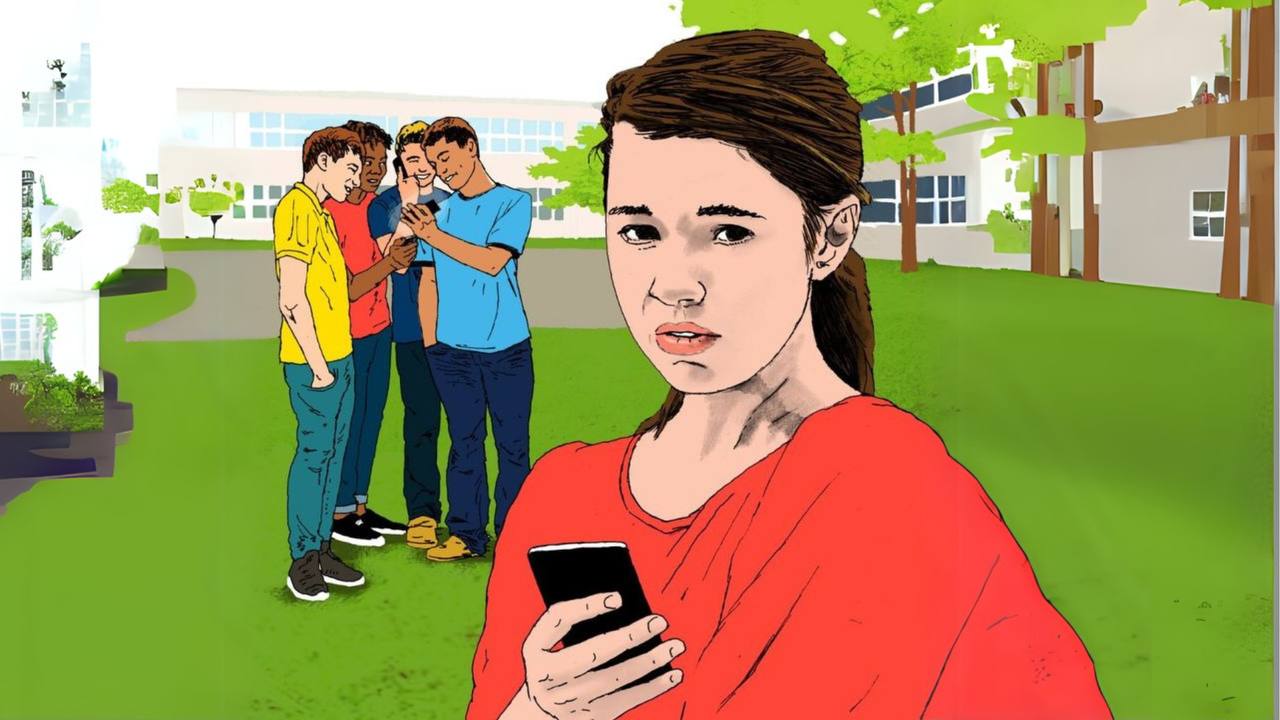Bullying: A Silent Epidemic with Lifelong Consequences
Bullying is more than just a childhood struggle—it is a deeply ingrained social issue that can leave lasting psychological scars. Defined as repeated aggressive behavior intended to harm, intimidate, or dominate another person, bullying takes many forms. Verbal bullying involves insults, name-calling, and humiliation, while physical bullying includes hitting, pushing, and other forms of violence.
In today’s digital age, cyberbullying has emerged as an even more insidious form, allowing bullies to target victims through social media, messaging apps, and online platforms, often without direct confrontation.
Additionally, relational aggression, such as social exclusion, spreading rumors, and manipulating friendships, can be just as damaging, eroding a child’s self-esteem over time.
Studies show that one in three students worldwide experiences some form of bullying, with the numbers rising in online spaces. A 2020 UNESCO report revealed that over 32% of students globally have been bullied at least once in a month, leading to school avoidance, anxiety, and long-term mental health issues.
In the digital world, cyberbullying is even harder to escape, with 24/7 exposure making victims feel trapped, powerless, and emotionally exhausted.
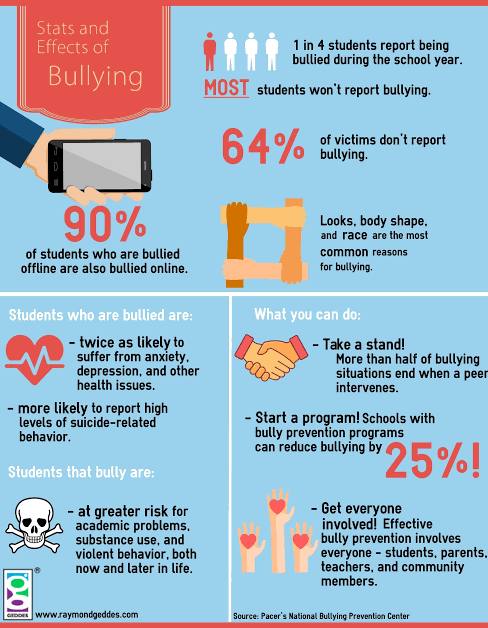
The image highlights the widespread issue of bullying, with 1 in 4 students reporting being bullied during the school year. It emphasizes the negative effects on both victims and perpetrators, while promoting intervention and prevention strategies.
Understanding the Psychology of Bullying: What Drives Aggression?
Bullying is not an isolated act of cruelty—it is a complex psychological and social phenomenon shaped by various factors. Understanding why children bully requires an examination of both psychological predispositions and environmental influences. Studies suggest that children who engage in bullying often come from homes where aggression is normalized, discipline is inconsistent, or emotional neglect is common.
According to research published in the Journal of Child Psychology and Psychiatry, children exposed to domestic violence are significantly more likely to display bullying behavior, as they may see dominance and intimidation as a way to gain control. Additionally, peer pressure plays a key role—many bullies seek approval from their social circles, believing that aggression enhances their status.
Bullying manifests in different forms, each with distinct but equally damaging psychological consequences. Physical bullying, often seen among younger children, fosters fear and helplessness in victims, leading to anxiety disorders. Verbal bullying, such as insults and derogatory remarks, gradually erodes self-esteem and contributes to depression.
Relational aggression, including exclusion and rumor-spreading, has been linked to long-term social anxiety and trust issues. Meanwhile, cyberbullying, which allows perpetrators to attack their victims anonymously, has been associated with higher rates of suicidal ideation compared to other forms of bullying.
The presence of bystanders significantly influences the bullying dynamic. Psychologists have found that when bystanders intervene, bullying stops within ten seconds in over 50% of cases, yet many remain silent due to fear or social conformity.
The Immediate Psychological Toll of Bullying
For children who experience bullying, the effects begin long before anyone notices. Anxiety, stress, and fear take root early, shaping how victims see themselves and the world around them. The constant anticipation of being ridiculed or harmed creates a state of chronic stress, similar to what trauma survivors experience.
A study published in the Journal of Abnormal Child Psychology found that children who are frequently bullied exhibit heightened cortisol levels, a biological marker of prolonged stress. This “fight or flight” response makes them hyper-aware of their surroundings, often leading to sleep disturbances, panic attacks, and difficulty concentrating.
As fear grows, many victims begin avoiding school, leading to a sharp decline in academic performance. According to a 2019 report by the National Center for Education Statistics, students who are bullied are twice as likely to skip school out of fear, resulting in falling grades and a loss of confidence in their abilities.
Some children who once thrived in the classroom suddenly struggle to participate, afraid of drawing attention to themselves. This creates a vicious cycle—academic decline further damages self-esteem, making the child even more vulnerable to bullying.
Research from the American Psychological Association indicates that children who experience social exclusion as a form of bullying are more likely to develop social anxiety and depressive symptoms in adolescence. The emotional pain of being rejected by peers can be as damaging as physical bullying, sometimes even more so.
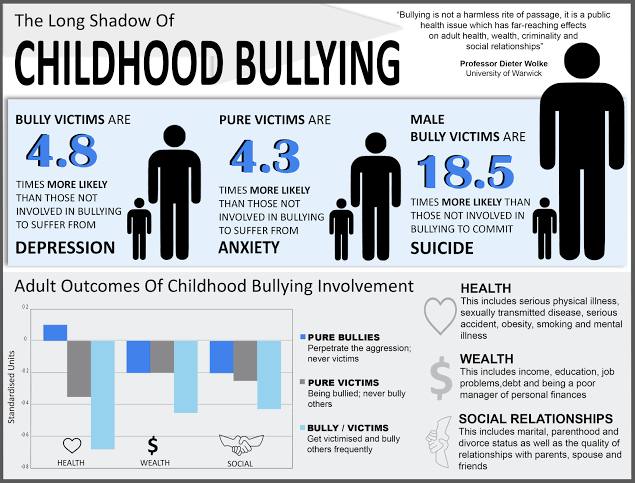
This infographic highlights the long-term impacts of childhood bullying, showing that victims are significantly more likely to suffer from depression, anxiety, and even suicidal tendencies. It also illustrates the negative effects on health, wealth, and social relationships in adulthood.
The psychological distress caused by bullying often manifests in physical symptoms. Headaches, stomachaches, muscle tension, and nausea are common complaints among bullied children. The Journal of Pediatric Psychology found that children who report frequent bullying are significantly more likely to experience psychosomatic symptoms, even in the absence of any medical illness.
Sleep disturbances are another major consequence, with victims frequently experiencing nightmares or insomnia, further deteriorating their mental and physical health.
The immediate effects of bullying are not just emotional—they impact a child’s entire well-being. Left unaddressed, these early warning signs can pave the way for more severe mental health challenges in the future.
The Lingering Scars: Long-Term Psychological Consequences of Bullying
For many victims, bullying does not end when they leave the schoolyard—it follows them into adulthood, shaping their mental health, self-perception, and even career trajectories. Decades of research have established that children who experience persistent bullying are at a significantly higher risk of developing depression, anxiety disorders, and post-traumatic stress disorder (PTSD) in adulthood.
A longitudinal study published in JAMA Psychiatry followed individuals for over 20 years and found that those who were bullied as children had higher rates of clinical depression and panic disorders well into their 30s and 40s. Many victims report experiencing flashbacks, hypervigilance, and emotional numbness, similar to symptoms seen in trauma survivors.
The impact on self-esteem and identity formation is another profound consequence. Constant belittling and social exclusion in childhood can lead to a deeply ingrained sense of worthlessness, making it difficult for victims to form healthy relationships later in life.
Psychologists at King’s College London found that adults who were bullied as children are more likely to struggle with trust issues, social withdrawal, and difficulty maintaining long-term relationships. Many victims carry the belief that they are not good enough, which affects their ability to pursue personal and professional opportunities.
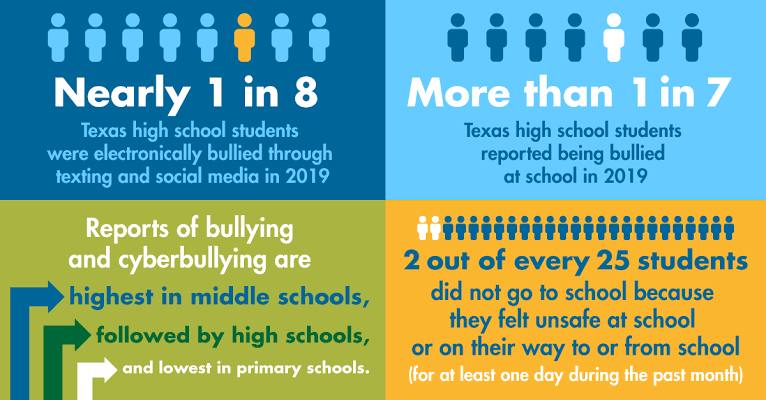
This image presents bullying statistics from Texas high schools, revealing that nearly 1 in 8 students were electronically bullied, while more than 1 in 7 reported in-school bullying. It emphasizes that bullying incidents are most frequent in middle schools.
Career success can also be impacted. Studies suggest that bullying disrupts cognitive development, problem-solving skills, and confidence, leading to poorer academic performance and career setbacks. Many victims experience a fear of authority figures, making it difficult to navigate workplace hierarchies. Some even report being bullied in professional settings, as patterns of victimization can persist into adulthood.
Perhaps the most devastating long-term consequence is the increased risk of suicidal ideation and self-harm. A report by the Centers for Disease Control and Prevention (CDC) found that victims of childhood bullying are at least twice as likely to attempt suicide compared to their peers.
Case studies have documented instances where adults, years after being bullied, still battle intrusive thoughts, self-doubt, and in some cases, severe mental distress leading to self-harm. The pain of bullying lingers far beyond childhood, emphasizing the urgent need for early intervention and long-term support.
The Hidden Damage: How Bullying Alters Brain Development
Bullying does not just affect emotions—it can physically alter the brain, leaving long-term consequences that persist well into adulthood. Chronic stress, caused by repeated bullying, affects key brain structures responsible for memory, emotional regulation, and decision-making.
Neuroimaging studies have revealed that victims of bullying exhibit structural changes in the amygdala, hippocampus, and prefrontal cortex, three regions critical to processing emotions and managing stress.
The amygdala, often called the brain’s “fear center,” becomes hyperactive in children who experience bullying, leading to an exaggerated stress response.
Research from King’s College London found that bullied children showed increased amygdala activity, making them more prone to anxiety, fear-based decision-making, and difficulty distinguishing between real and perceived threats. This overactivity explains why many victims suffer from hypervigilance and social anxiety long after the bullying has stopped.
The hippocampus, responsible for memory and learning, also shrinks under prolonged stress. A study published in Molecular Psychiatry found that victims of severe childhood bullying had a significantly smaller hippocampus volume, impairing their ability to regulate emotions and process new information. This neurological damage can impact academic performance, reduce cognitive flexibility, and increase susceptibility to depression.
Perhaps most concerning is the effect of bullying on the prefrontal cortex, the part of the brain that governs impulse control, problem-solving, and decision-making. In bullied children, this region develops more slowly, leading to difficulties in emotional regulation and a higher likelihood of engaging in self-destructive behaviors.
Harvard researchers suggest that these changes mirror those seen in individuals who have experienced long-term trauma, reinforcing the idea that bullying is not a mere social hardship but a serious neurological stressor.
The biological scars of bullying highlight the urgent need for intervention. Without support, victims may struggle with lifelong difficulties in managing emotions, making rational choices, and forming healthy relationships—all because of the trauma their brains were forced to endure.
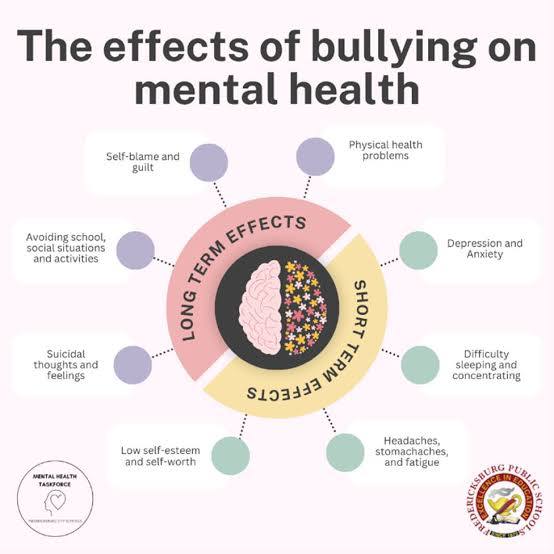
The visual demonstrates the mental health consequences of bullying, categorizing them into short-term effects like headaches and anxiety, and long-term effects such as low self-esteem and suicidal thoughts.
Broken Bonds: How Bullying Shapes Adult Relationships
The wounds inflicted by bullying do not disappear with age—they reshape how victims interact with others, often creating lifelong struggles with trust, intimacy, and social confidence. Many adults who were bullied as children find it difficult to form deep relationships, as the fear of rejection, humiliation, or betrayal remains ingrained in their psyche. According to a study published in Social Psychiatry and Psychiatric
Epidemiology, individuals who experienced childhood bullying are significantly more likely to struggle with trust issues and social withdrawal, making it hard for them to build and maintain close friendships or romantic partnerships.
For some, this fear of intimacy leads to a pattern of unhealthy relationships, where victims either avoid deep emotional connections or gravitate toward toxic dynamics. Psychologists have observed that adults who were bullied in childhood are at a higher risk of entering abusive relationships, as prolonged bullying conditions them to tolerate mistreatment and internalize the belief that they do not deserve better.
This cycle of victimization can manifest in both personal and professional relationships, leading to feelings of loneliness, self-doubt, and emotional dependence.
Another disturbing consequence of childhood bullying is the bully-victim cycle, where victims, in some cases, become aggressors themselves. Research from the American Psychological Association indicates that children who were bullied are more likely to exhibit aggressive behaviors in adulthood, sometimes adopting bullying tendencies as a defense mechanism.
Breaking the Cycle: Strategies for Preventing and Addressing Bullying
Bullying is not an inevitable part of childhood—it is a preventable social issue that requires vigilance, education, and structured intervention. The responsibility to stop bullying falls on parents, teachers, and policymakers, all of whom play a crucial role in identifying warning signs and fostering a culture of kindness.
Parents and teachers serve as the first line of defense against bullying. Many children do not openly talk about being bullied due to fear, embarrassment, or the belief that no one will help. This makes it critical for adults to recognize subtle behavioral changes, such as a sudden drop in academic performance, school avoidance, unexplained physical complaints, or withdrawal from social activities.
According to a study published in the Journal of School Psychology, early intervention by a trusted adult can reduce the severity of bullying’s psychological impact and prevent escalation. Schools must create an environment where students feel safe reporting incidents without fear of retaliation.
School-based therapy programs that incorporate counseling, peer mediation, and emotional regulation training have shown success in helping both victims and perpetrators. Research from the American Journal of Psychiatry highlights that structured therapy programs significantly reduce long-term mental health issues associated with bullying, including anxiety and depression.
Prevention, however, starts much earlier—teaching empathy and resilience from a young age is one of the most effective ways to curb bullying behavior. Schools that implement social-emotional learning (SEL) programs, which focus on emotional intelligence, conflict resolution, and kindness, report lower instances of bullying and higher student engagement.
Encouraging children to understand the emotions of others, practice kindness, and stand up for their peers creates a culture where bullying is less likely to thrive. According to research by Harvard University, children who engage in structured empathy-building exercises show a 40% increase in prosocial behaviors, making them less likely to bully or tolerate bullying in their environment.
At a broader level, anti-bullying policies and school-wide intervention programs have proven to be highly effective. Countries like Finland have pioneered initiatives such as the KiVa program, which has led to a decrease in bullying rates by nearly 30% in participating schools.
This program focuses on teacher training, student workshops, and strict anti-bullying enforcement, making it a model for global anti-bullying strategies. Similarly, the Olweus Bullying Prevention Program, widely implemented in the United States, has shown success in reducing bullying incidents by up to 50% through school-wide policy changes and increased adult supervision in high-risk areas like hallways and playgrounds.
Reducing bullying requires a combination of awareness, early intervention, psychological support, and systemic policy changes. It is not just about punishing bullies but about reshaping the environment so that bullying becomes socially unacceptable. By fostering a culture of empathy, accountability, and open dialogue, schools and communities can ensure that children grow up in environments where they feel safe, valued, and empowered to stand against bullying.
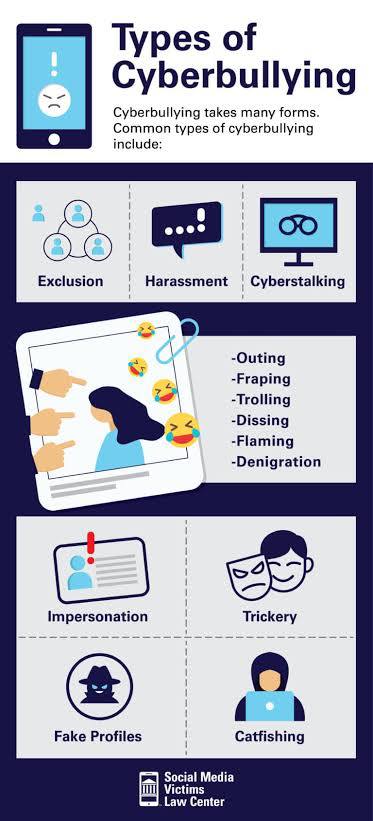
This infographic outlines the various types of cyberbullying, including harassment, cyberstalking, impersonation, and catfishing. It also lists specific actions like trolling, flaming, and outing.
Turning Pain into Change: The Urgent Need to Address Bullying
The effects of bullying do not fade with time—they leave deep psychological scars that can last a lifetime. From increased risks of depression, anxiety, and PTSD to difficulties in forming relationships and pursuing successful careers, the consequences of bullying extend far beyond childhood.
Studies have repeatedly shown that victims of bullying are more likely to struggle with self-esteem issues, social withdrawal, and even suicidal ideation well into adulthood. The damage is not only emotional but also neurological, with research indicating that chronic bullying alters brain structure, affecting emotional regulation and cognitive development.
Yet, bullying is not an unsolvable problem. The key lies in early intervention and prevention, ensuring that children receive support before the damage becomes permanent. Schools must prioritize social-emotional learning, enforce anti-bullying policies, and provide psychological support for both victims and perpetrators.
Parents and teachers must remain vigilant, recognizing the early signs of distress and fostering open conversations where children feel safe discussing their experiences. Governments and policymakers must ensure that effective anti-bullying laws and educational reforms are in place, creating a zero-tolerance culture against harassment.
While the challenges are great, so is the potential for change. Across the world, successful intervention programs have shown that a collective effort can significantly reduce bullying rates and create safer environments for children.
But this transformation requires action—not just from educators and lawmakers but from every individual who interacts with a child. By teaching empathy, promoting kindness, and refusing to turn a blind eye, society can break the cycle of bullying and offer every child the opportunity to grow up feeling valued, safe, and empowered.
The scars of bullying may be deep, but they do not have to define a person’s future. With awareness, action, and compassion, we can ensure that no child has to suffer in silence ever again.
FAQs on Bullying and Its Long-Term Psychological Consequences
What is bullying, and how does it differ from normal childhood conflicts?
Bullying is intentional, repetitive aggression that involves a power imbalance. Unlike occasional disagreements, bullying includes verbal, physical, cyber, or relational harm aimed at intimidating or isolating a victim.
What are the different types of bullying?
Bullying can be physical (hitting, pushing), verbal (name-calling, threats), relational (social exclusion, spreading rumors), and cyberbullying (harassment via social media or messages).
How common is bullying among children and teenagers?
According to UNICEF, one in three students worldwide experiences bullying. The prevalence varies across regions, with cyberbullying becoming increasingly widespread due to digital access.
What causes children to bully others?
Factors like family environment, peer pressure, low self-esteem, and a need for power contribute to bullying behavior. Some bullies come from abusive households, while others imitate aggressive behavior seen at home or online.
How does bullying impact a child’s mental health immediately?
Victims often experience stress, anxiety, depression, fear, and social withdrawal. Many report physical symptoms like headaches, stomach aches, and sleep disturbances due to psychological distress.
Can bullying affect a child’s academic performance?
Yes, bullied children often suffer from concentration issues, declining grades, and school avoidance, sometimes leading to higher dropout rates.
What are the immediate social effects of bullying?
Victims may struggle to make friends, withdraw from social activities, and develop trust issues, making it harder for them to form healthy relationships.
Can bullying lead to mental health disorders in adulthood?
Research shows that victims of childhood bullying are at a higher risk of developing anxiety disorders, depression, PTSD, and even substance abuse problems later in life.
How does bullying impact self-esteem and identity development?
Victims often develop negative self-perception, feelings of worthlessness, and a fear of social interactions, which can persist into adulthood.
Does childhood bullying affect career and workplace experiences?
Adults who were bullied as children may struggle with authority figures, workplace anxiety, and difficulty handling criticism, sometimes affecting their professional growth.
Is there a link between bullying and suicidal thoughts?
Studies indicate that children and teenagers who are bullied have a significantly higher risk of suicidal ideation and self-harm, especially when bullying is persistent.
Can bullying change brain development?
Yes, chronic stress from bullying can alter brain structures like the amygdala, hippocampus, and prefrontal cortex, affecting emotional regulation, memory, and decision-making.
How does bullying affect adult relationships?
Victims often struggle with trust, intimacy, and maintaining friendships or romantic relationships, fearing rejection or betrayal.
Are victims of bullying more likely to enter toxic relationships?
Some victims tolerate mistreatment or seek validation in unhealthy relationships, as bullying conditions them to accept negative treatment.
Can a bullied child become a bully in adulthood?
In some cases, victims develop aggressive or controlling behaviors as a defense mechanism, creating a bully-victim cycle.
How can parents identify if their child is being bullied?
Warning signs include sudden mood changes, reluctance to go to school, unexplained injuries, lost belongings, and withdrawal from social activities.
What role do teachers play in preventing bullying?
Teachers can create a safe environment, educate students on empathy, implement anti-bullying policies, and intervene when they witness bullying behavior.
What psychological interventions help bullying victims recover?
Cognitive Behavioral Therapy (CBT), counseling, support groups, and school-based intervention programs help victims regain confidence and heal from trauma.
Do anti-bullying programs in schools work?
Yes, research-backed programs like KiVa (Finland) and the Olweus Bullying Prevention Program (U.S.) have successfully reduced bullying rates by focusing on awareness, peer intervention, and adult supervision.
What can society do to reduce bullying and its impact?
A collective effort is needed, including stricter anti-bullying laws, school and workplace policies, mental health support, and fostering a culture of kindness and empathy.

